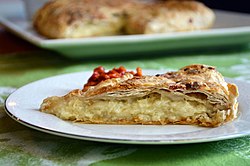Gibanica

A piece of Gibanica.
|
|
| Alternative names | Gužvara (Crumpled pie) |
|---|---|
| Type | Pastry |
| Place of origin | Serbia |
| Region or state | Balkans |
| Serving temperature | Hot or cold |
| Main ingredients | phyllo dough, white cheese (feta, sirene), eggs |
| Other information | Other ingredients include milk, kaymak and lard or sunflower oil |
| |
|
| Nutritional value per 100 g (3.5 oz) | |
|---|---|
| Energy | 1,255 kJ (300 kcal) |
|
15.4 g
|
|
|
22.2 g
|
|
|
9.9 g
|
|
|
|
Gibanica (Serbian Cyrillic: Гибаница, [ˈɡibanit͡sa]) is a traditional pastry dish from Serbia popular all over the Balkans. It is usually made with white cheese and eggs. Recipes can range from sweet to savoury, and from simple to festive and elaborate multi-layered cakes.
A derivative of the Serbian verb , meaning "to fold; sway, swing, rock", the pastry was mentioned in Serbian linguist Vuk Stefanović Karadžić's Serbian dictionary in 1818. It is traditionally served for breakfast with kefir or plain yogurt. Other than in the Balkans, Gibanica can be found worldwide in restaurants serving Serbian cuisine. It is one of the most popular and recognizable pastry dishes from the Balkans, whether served on festive occasions, or as a comforting family snack. In Serbia, the dish is often consumed at traditional events such as Christmas, Easter and Slava.
In the vocabulary of the Yugoslav Academy, as well as in the etymological dictionary of Slavic languages, the word gibanica is a derivative of the Serbian verb /, which means "to fold; sway, swing, rock". There are also word derivatives like the Serbo-Croatian word gibaničar/гибаничар (one who makes gibanica, one who loves to eat gibanica, and one who always imposes as a guest and at someone else's expense.)
...
Wikipedia
